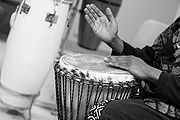
Music of Africa
Did you know...
SOS believes education gives a better chance in life to children in the developing world too. SOS Children has looked after children in Africa for forty years. Can you help their work in Africa?
The music of Africa is as vast and varied as the continent's many regions, nations and ethnic groups. Although there is no distinctly pan-African music, there are common forms of musical expression, especially within regions.
Some musical genres of northern and northeastern Africa, and the Islands off East Africa, share both traditional African and Middle Eastern features.
The music and dance forms of the African diaspora, including many Caribbean and Latin American music genres like rumba and salsa, as well as African American music, were founded to varying degrees on musical traditions from Africa, taken there by African slaves.
Musical instruments
Besides using the voice, which has been developed to use various techniques such as complex melisma and yodel, a wide array of musical instruments are used. African musical instruments include a wide array of drums, slit gongs, rattles, double bells as well as melodic instruments like string instruments, ( musical bows, different types of harps and harp-like instruments like the Kora as well as fiddles), many types of xylophone and lamellophone such as the mbira and different types of wind instrument like flutes and trumpets.
Drums used in African traditional music include tama talking drums, bougarabou and djembe in West Africa, water drums in Central and West Africa, and the different types of ngoma drums (pronounced by some "engoma") in Central and Southern Africa.
Relationship to language
Many African languages are tonal languages, leading to a close connection between music and language in many African cultures. In singing, the tonal pattern or the text puts some constraints on the melodic patterns. On the other hand, in instrumental music a native speaker of a language can often perceive a text or texts in the music. This effect also forms the basis of drum languages ( talking drums).
Relationship to dance
The treatment of "music" and "dance" as separate art forms is a European idea. In many African languages there is no concept corresponding exactly to these terms. For example, in many Bantu languages, there is one concept that might be translated as "song" and another that covers both the semantic fields of the European concepts of "music" and "dance". So there is one word for both music and dance (the exact meaning of the concepts may differ from culture to culture).
For example, in Kiswahili, the word "ngoma" may be translated as "drum", "dance", "dance event", "dance celebration" or "music", depending on the context. Each of these translations is incomplete.
Therefore, from an intracultural point of view, African music and African dance must be viewed in very close connection. The classification of the phenomena of this area of culture into "music" and "dance" is foreign to many African cultures.
Traditional music
A lot of African traditional music is or was performed by professional musicians. Some of it is belong to court music or sacral music traditions, therefore the term "folk" music is not always appropriate. Nevertheless, both the terms "folk music" and "traditional music" can be found in the literature.
Sub-Saharan African folk music and traditional music is mostly functional in nature. There are, for example, many different kinds of work songs, ceremonial or religious music and courtly music performed at royal courts, but none of these are performed outside of their intended social context.
Music is highly functional in African ethnic life, accompanying childbirth, marriage, hunting, and even political activities. Similarities with other cultures, particularly Indian and Middle Eastern, can be ascribed primarily to the spread of Islam.
Popular music
Influence in American music
African music has been a major factor in the shaping of what we know today as blues and jazz. These styles have all, to some extent, borrowed from African rhythms and sounds, brought over the Atlantic ocean by slaves. Paul Simon, on his album " Graceland" has used African bands and music along with his own lyrics.
As the rise of rock'n'roll music is often credited as having begun with 1940s blues music, and with so many genres having branched off from rock - the myriad subgenres of heavy metal, punk rock, pop music and many more - it can be argued that African music has been at the root of a very significant portion of all contemporary music.



